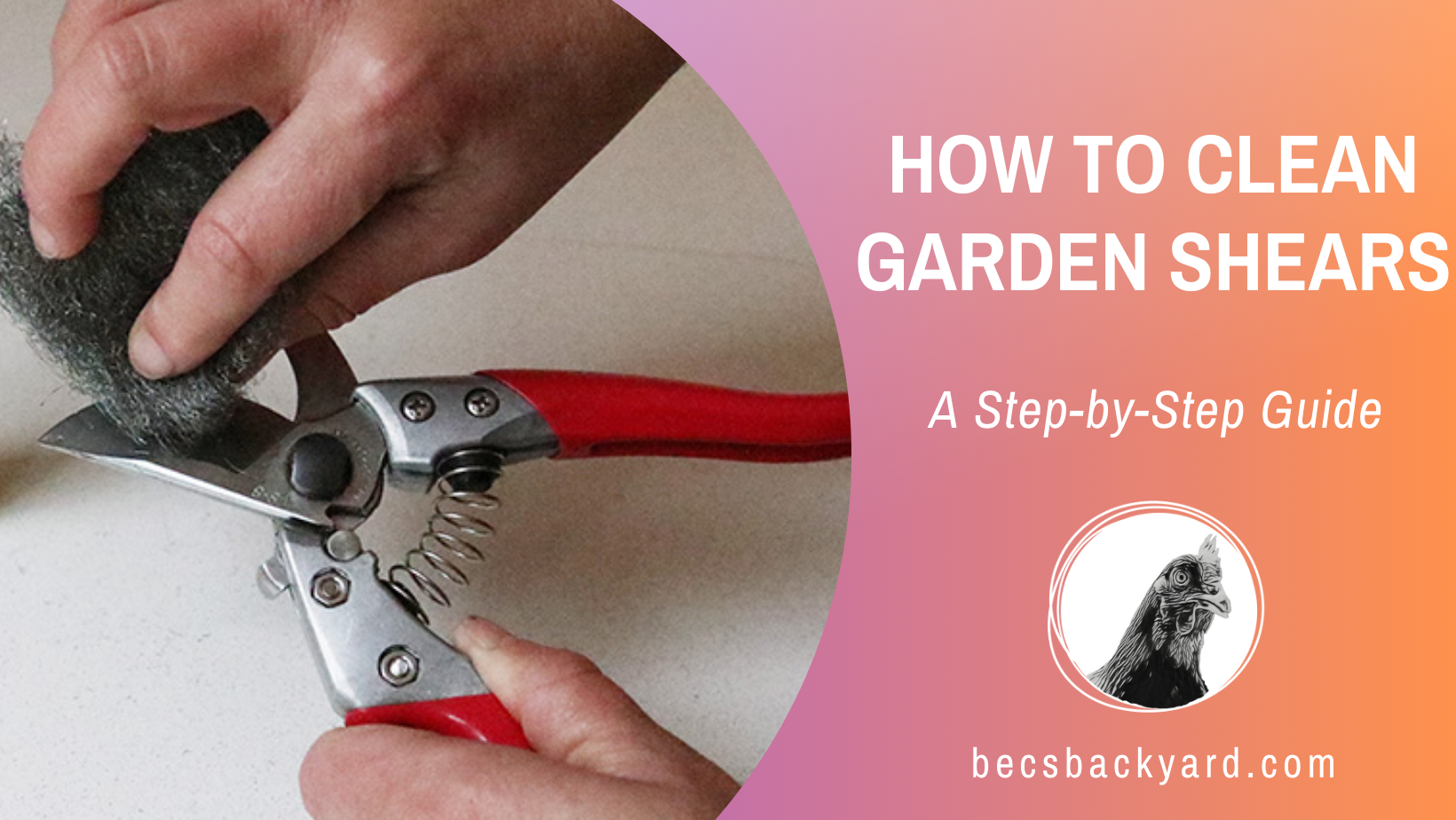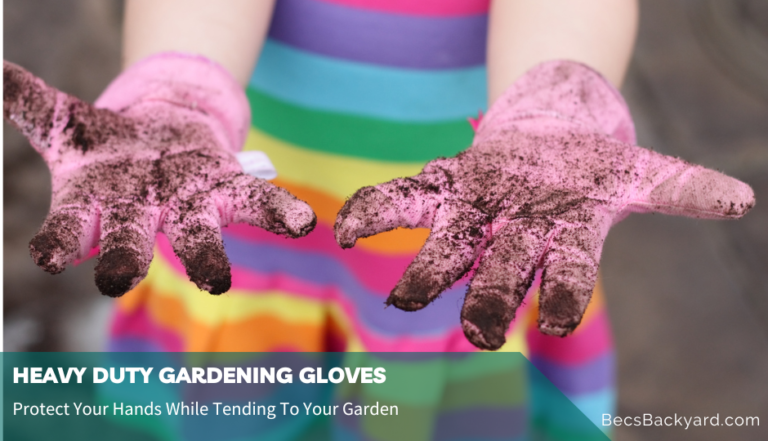How to Clean Garden Shears: A Step-by-Step Guide

Here we provide a step by step guide on How to Clean Garden Shears. Cleaning your garden shears is an essential part of maintaining your gardening tools. Over time, dirt, sap, and rust can accumulate on the blades, which can make them less effective and even damage them. Proper cleaning and maintenance can help prolong the life of your shears and ensure that they are always ready for use when you need them.
Why Cleaning Garden Shears is Important
Cleaning your garden shears is an important task that should not be overlooked. Keeping your shears clean will help maintain their efficiency and prolong their lifespan. It will also help prevent the spread of diseases and pests that can harm your plants.
In addition to preventing the spread of disease, cleaning your shears will also help prevent the spread of pests. Pests can easily hide in the dirt and debris that accumulates on your shears. By cleaning your shears, you can remove any pests that may be hiding and prevent them from spreading to other plants.
Cleaning your shears will also help maintain their efficiency. Dirty shears can become clogged with debris, which can make it difficult to make a clean cut. By cleaning your shears, you can ensure that they are always sharp and ready to use.
How to Clean Garden Shears : The Preparation
Before you start cleaning your garden shears, you need to prepare the tools and the area where you will be cleaning them. Here are some steps to follow:
Wear gloves: Protect your hands by wearing gloves. This will also prevent any dirt or grime from getting on your skin.
Disassemble the shears: If possible, disassemble the shears so you can clean all the parts thoroughly. Refer to the manufacturer’s instructions if you are not sure how to do this.
Remove dirt and debris: Use a dry cloth or an old toothbrush to remove any dirt and debris from the blades and other parts of the shears.
Soak the shears: Fill a bucket with warm water and add a mild detergent or dish soap. Soak the shears in the solution for a few minutes to loosen any dirt or grime.
Scrub the shears: Use a wire brush or an old toothbrush to scrub the blades and other parts of the shears. Be sure to get into all the nooks and crannies.
Rinse and dry: Rinse the shears thoroughly with clean water and dry them with a microfiber cloth or a clean rag. Make sure to dry all the parts completely to prevent rust from forming.
By following these steps, you can ensure that your garden shears are clean and ready for use.
Removing Rust and Dirt
Garden shears are prone to rust and dirt buildup, which can affect their performance and lifespan. Fortunately, there are several ways to remove rust and dirt from your garden shears, including:
Soaking in Vinegar
Vinegar is a popular and effective method for removing rust from garden shears. Simply soak the shears in white vinegar for several hours or overnight. Then, use a wire brush or steel wool to scrub away any remaining rust. Rinse the shears with water and dry them thoroughly before using.
Scrubbing with Sandpaper
If the rust on your garden shears is particularly stubborn, you may need to resort to sandpaper. Use fine-grit sandpaper to scrub away the rust, being careful not to damage the blades. Afterward, rinse the shears with water and dry them thoroughly.
Using All-Purpose Cleaner
Another option for removing rust and dirt from garden shears is to use an all-purpose cleaner. Apply the cleaner to the blades and let it sit for several minutes. Then, use a wire brush or steel wool to scrub away the rust and dirt. Rinse the shears with water and dry them thoroughly.
Preventing Rust and Dirt Buildup
To prevent rust and dirt buildup on your garden shears, it’s important to clean and dry them after each use. Store them in a dry place, away from moisture and humidity. You can also apply a thin layer of oil to the blades to protect them from rust.
By following these simple steps, you can keep your garden shears clean, rust-free, and in good working condition for years to come.
Cleaning the Blades
Keeping your garden shears clean is important for maintaining their performance and longevity. Clean blades ensure a clean cut, which is essential for the health of your plants. Here are some steps you can take to clean your garden shears and ensure they are ready to use whenever you need them.
- First, fill a bucket with warm water and add a few drops of dish soap to create a soapy solution.
- Next, use a toothbrush or wire brush to scrub the blades of your garden shears. Be sure to remove any dirt or debris that may have accumulated on the blades.
- Rinse the blades with clean water to remove any remaining soap residue.
- Dry the blades with a clean, dry cloth. Be sure to remove any moisture from the blades to prevent rust or other damage.
For an extra clean, you can also soak the blades in a solution of equal parts water and vinegar for a few minutes before rinsing and drying.
Remember to always clean your garden shears after each use to prevent the buildup of dirt and debris. This will help ensure that your shears are always ready to use when you need them.
Disinfecting the Shears
It is important to disinfect your garden shears regularly to prevent the spread of diseases and pests. Here are some steps you can follow to disinfect your garden shears effectively:
- Clean the Shears: Before disinfecting your garden shears, clean them thoroughly with water and a wire brush to remove any dirt, debris, or sap. This will ensure that the disinfectant solution can penetrate all areas of the shears.
- Choose a Disinfectant: There are several disinfectants that you can use to disinfect your garden shears, including alcohol and bleach. Isopropyl alcohol, also known as rubbing alcohol, is a common disinfectant that can be used to disinfect your garden shears. You can also use a bleach solution to disinfect your shears.
- Disinfect the Shears with Alcohol: To disinfect your garden shears with alcohol, soak a clean cloth or cotton ball in isopropyl alcohol and wipe down the blades and handles of the shears. Make sure to cover all areas of the shears and allow the alcohol to evaporate before using them again.
Disinfect the Shears with Bleach: To disinfect your garden shears with bleach, mix a solution of one part bleach to nine parts water in a bucket. Submerge the shears in the solution for at least 30 minutes, then rinse them thoroughly with water and dry them completely.
Remember to wear gloves and protective eyewear when handling bleach, and avoid using bleach on stainless steel or aluminum tools as it can cause discoloration or corrosion.
Once you have cleaned your garden shears, it’s time to sharpen the blades. Dull blades can damage plants and make pruning a frustrating experience. Here are the steps to sharpen your garden shears:
Disassemble the shears: Start by disassembling the shears. This will allow you to access the blades and sharpen them more effectively. Follow the manufacturer’s instructions for disassembly, or if you’re unsure, consult a professional.
Choose your sharpening tool: You can use a sharpening file, sharpening stone, or diamond file to sharpen your garden shears. A sharpening file is the most common tool used for sharpening garden shears. Make sure the file is the appropriate size for the blades.
Sharpen the blades: Hold the sharpening tool at the same angle as the bevel on the blade. Move the tool along the blade in a sweeping motion, starting from the base of the blade and moving towards the tip. Repeat this motion on the other blade. Be sure to maintain the same angle throughout the process.
Check for burrs: After sharpening the blades, check for burrs. Burrs are small metal filings that can be left behind on the blade after sharpening. Use a sharpening stone or diamond file to remove any burrs.
Reassemble the shears: Once you have finished sharpening and removing any burrs, reassemble the shears. Follow the manufacturer’s instructions or seek professional assistance if needed.
Test the shears: Test the shears by making a few cuts on a piece of paper or cardboard. If the shears cut cleanly, you’re good to go. If not, repeat the sharpening process until the shears cut cleanly.
Remember, it’s important to sharpen your garden shears regularly to keep them in good working condition. A sharp blade not only makes pruning easier, but it also helps keep your plants healthy.
Oiling the Shears
To keep your garden shears in top condition, it’s important to oil them regularly. Oiling your shears will help prevent rust and keep the blades moving smoothly. Here are some steps to follow:
Choose the right oil: You can use a variety of oils to lubricate your shears, including vegetable oil, olive oil, or a specialized tool lubricant. Avoid using WD-40, as it can actually cause damage to the blades over time.
Apply the oil: Use a clean cloth to apply a small amount of oil to the blades and pivot point of your shears. Be sure to wipe away any excess oil with a clean cloth.
Store your shears properly: After oiling your shears, store them in a dry place to prevent rust. You can also wrap them in a clean cloth or paper towel to help absorb any excess oil.
By oiling your shears regularly, you can help extend their lifespan and ensure they continue to work effectively. Just be sure to choose the right oil and follow the proper application process.
Reassembling and Storing the Shears
Now that you have cleaned and sharpened your garden shears, it’s time to reassemble them and store them properly. Follow these simple steps to ensure your shears stay in good condition:
Reassemble the Shears:
- Put the blades back together, making sure they are aligned properly.
- Tighten the pivot screw until it is snug, but not too tight.
- Test the shears to make sure they are cutting properly.
Protect the Blades:
- Apply a light coat of oil to the blades to prevent rust and corrosion.
- You can use any type of oil, such as vegetable oil or mineral oil.
- Be sure to wipe off any excess oil with a clean cloth.
Season the Shears:
- To prevent the blades from sticking, rub a small amount of beeswax or paraffin wax on them.
- This will also help protect the blades from rust and corrosion.
Store the Shears:
- Hang the shears on a pegboard or store them in a tool box.
- Make sure they are not touching any other metal objects, as this can cause them to rust.
- If possible, store them in a dry location to prevent moisture buildup.
By following these simple steps, you can ensure your garden shears stay in good condition and last for many years to come.
Maintaining Garden Shears
Garden shears are essential tools for any gardener, and proper maintenance is crucial to ensure they function efficiently. Routine maintenance of your garden shears will help prevent rust, ensure they remain sharp, and extend their lifespan.
One of the most important maintenance tasks is sharpening the blades. Dull blades can cause damage to plants and make pruning more difficult. To sharpen your garden shears, you can use a sharpening stone or a file. Make sure to follow the manufacturer’s instructions for sharpening your specific type of shears.
Cleaning pruning shears is another important maintenance task. After use, wipe the blades with a cloth to remove any dirt or debris. If the blades are particularly dirty, you can use a wire brush to remove any stubborn dirt. To prevent rust, apply a thin layer of oil to the blades after cleaning.
Regularly inspect your garden shears for any signs of wear and tear. If you notice any damage, such as bent or broken blades, replace the shears immediately. Using damaged shears can cause further damage to your plants and make pruning more difficult.
In addition to maintaining your garden shears, it’s important to store them properly. Store them in a dry place, away from moisture, to prevent rust. You can also use a blade cover to protect the blades from damage.
By following these simple maintenance tips, you can ensure that your garden shears remain sharp and functional for years to come.
Frequently Asked Questions
What are some effective ways to clean garden shears?
Cleaning your garden shears is essential to keep them in good condition and prevent the spread of diseases. Here are some effective ways to clean garden shears:
>Use a wire brush or putty knife to remove any dirt or debris from the shears.
>Soak the blades in a solution of warm water and dish soap for 10-15 minutes.
>Scrub the blades with a soft-bristled brush to remove any remaining dirt or rust.
>Rinse the blades thoroughly with clean water and dry them with a clean towel.
Can I use vinegar to clean my pruning shears?
Yes, you can use vinegar to clean your pruning shears. Vinegar is a natural disinfectant and can help remove rust and other stains from the blades. To clean your pruning shears with vinegar, mix equal parts white vinegar and water in a bowl. Soak the blades in the solution for 10-15 minutes, then scrub them with a soft-bristled brush. Rinse the blades with clean water and dry them with a clean towel.
How do I disinfect my garden tools?
To disinfect your garden tools, mix 1 part bleach with 9 parts water in a bucket. Soak your tools in the solution for 5-10 minutes, then rinse them with clean water and dry them with a clean towel. This will help kill any bacteria or fungi that may be present on the tools.
What are some common mistakes to avoid when cleaning garden shears?
>Using abrasive materials that can scratch the blades.
>Not drying the blades thoroughly after cleaning, which can lead to rust.
>Using harsh chemicals that can damage the blades or handles.
>Not disassembling the shears before cleaning, which can make it difficult to clean all the nooks and crannies.
What household items can I use to clean my loppers?
You can use a variety of household items to clean your loppers, including:
>White vinegar
>Baking soda
>Lemon juice
>Dish soap
>Rubbing alcohol
Mix these items with water to create a cleaning solution, then use a soft-bristled brush to scrub the blades and handles. Rinse the loppers with clean water and dry them with a clean towel.
Is it safe to use Clorox wipes on pruning shears?
Yes, it is safe to use Clorox wipes on pruning shears. Clorox wipes contain bleach, which is a natural disinfectant that can help kill bacteria and other pathogens. To clean your pruning shears with Clorox wipes, simply wipe down the blades and handles with the wipes, then rinse them with clean water and dry them with a clean towel.






